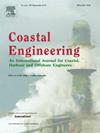A new method to measure damage progression in Homogeneous Low-Crested Structures with a low-cost 3D depth-sensor
IF 4.2
2区 工程技术
Q1 ENGINEERING, CIVIL
引用次数: 0
Abstract
Mechanical profilers are commonly used to measure damage to rubble mound breakwaters in small-scale physical tests. This study developed a non-intrusive methodology using low-cost 3D depth-sensors to measure damage progression in Homogeneous Low-Crested Structures (HLCS) with and without water in the wave flume. Although light refraction causes distortion in the presence of water, distorted scans are corrected with this new method using a Neural Network (NN) model. The new methodology is adequate to obtain undistorted profiles of emerged or submerged breakwaters and may be described in two steps: (1) a digital profiler algorithm, to describe the breakwater models in series of profiles in order to measure damage, and (2) a trained NN model, to correct the distortions caused by light refraction for the scans taken with water in the wave flume. The NN model to correct profiles requires two sets of scans, one in empty conditions and the other in submerged conditions; the two scans (dry-wet) can be easily obtained without disturbing the usual test programs. This is done by taking the scans at the beginning (dry and wet) and at the end (wet and dry) of each test series. By comparing profiles, the breakwater damage can be analysed after obtaining the series of undistorted profiles from the trained NN model and the distorted scans. To validate the method, a series of small-scale physical tests with Cubipod HLCS were carried out from no damage to severe damage, and then the estimations given by the trained NN models were compared with blind observations, taken from additional pairs of dry and wet scans. The good agreement between the observations and the estimations (R2 > 0.985, r > 0.993) showed that low-cost 3D depth-sensors may be used as non-intrusive methods for breakwater profiling, even when scanning is done with water in the wave flume or basin.
采用低成本三维深度传感器测量均匀低冠结构损伤进展的新方法
机械剖面仪是小型物理试验中常用的碎石丘防波堤损伤测量方法。本研究开发了一种非侵入式方法,使用低成本的3D深度传感器来测量波浪水槽中有无水的均匀低冠结构(HLCS)的损伤进展。尽管在有水的情况下,光的折射会导致畸变,但这种新方法使用神经网络(NN)模型来校正畸变扫描。新方法足以获得出现或淹没的防波堤的无损剖面,并且可以分为两个步骤来描述:(1)数字剖面仪算法,以一系列剖面来描述防波堤模型,以便测量损坏情况;(2)训练好的神经网络模型,校正波浪水槽中水扫描时光折射引起的畸变。校正轮廓的神经网络模型需要两组扫描,一组在空条件下,另一组在淹没条件下;这两种扫描(干湿)可以很容易地获得,而不干扰通常的测试程序。这是通过在每个测试系列的开始(干湿)和结束(干湿)进行扫描来完成的。通过对比剖面,将训练好的神经网络模型和畸变扫描得到一系列无损剖面,从而对防波堤损伤进行分析。为了验证该方法,对Cubipod HLCS进行了一系列从无损伤到严重损伤的小规模物理测试,然后将训练好的NN模型给出的估计与盲观察结果进行比较,盲观察结果来自额外的干湿扫描对。观测值与估计值之间的良好一致性(R2 >;0.985, r >;0.993)表明,低成本的三维深度传感器可以作为防波堤剖面的非侵入式方法,即使对波浪水槽或盆地中的水进行扫描也是如此。
本文章由计算机程序翻译,如有差异,请以英文原文为准。
求助全文
约1分钟内获得全文
求助全文
来源期刊

Coastal Engineering
工程技术-工程:大洋
CiteScore
9.20
自引率
13.60%
发文量
0
审稿时长
3.5 months
期刊介绍:
Coastal Engineering is an international medium for coastal engineers and scientists. Combining practical applications with modern technological and scientific approaches, such as mathematical and numerical modelling, laboratory and field observations and experiments, it publishes fundamental studies as well as case studies on the following aspects of coastal, harbour and offshore engineering: waves, currents and sediment transport; coastal, estuarine and offshore morphology; technical and functional design of coastal and harbour structures; morphological and environmental impact of coastal, harbour and offshore structures.
 求助内容:
求助内容: 应助结果提醒方式:
应助结果提醒方式:


